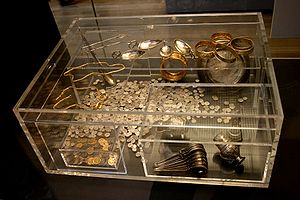 This rare and exquisite gold bejeweled body chain dates back to 5th century Britain. It once belonged to young girl or petite woman from a well-to-do family.
This rare and exquisite gold bejeweled body chain dates back to 5th century Britain. It once belonged to young girl or petite woman from a well-to-do family.It definitely added refinement and social statement to what would otherwise be coarsely woven garments in those days. I think this jewelry style would still look stunning today on a plain evening gown with the right cut.
The body chain was part of the fabulous Hoxne (pronounced "Hoxon") Hoard, named after the village where it was found in Sussex, England in 1992.
It is the largest hoard, some 15,000 items, ever found from that era. This treasure trove netted the metal detectorist and the tenant farmer a total of £1.75 million which they shared equally. Several pieces are now on permanent display in the British Museum which purchased the hoard.
 Display of Hoxne Hoard showing item placement when found via Wikipedia
Display of Hoxne Hoard showing item placement when found via WikipediaFrom the coins in the hoard, archaeologists determined that the treasure was buried sometime after 406/7 A.D. The disintegration of the mighty Roman Empire was occurring around this time. The breakdown of Roman rule plunged Britain into anarchy which likely explains why these precious belongings were buried for safekeeping. Surely something dreadful must have happened to the family for the hoard was never retrieved.
Photo : Courtesy of the British Museum
Reference
Original Post by THE BEADING GEM
Jewelry Making Tips - Jewelry Business Tips
Love that piece! Body chain necklaces are becoming quite a trend, and a there's a brand called Kallisti specializes in them though it's a bit more paired down compare to this one http://www.kallistifashion.com. Enjoy!
ReplyDelete